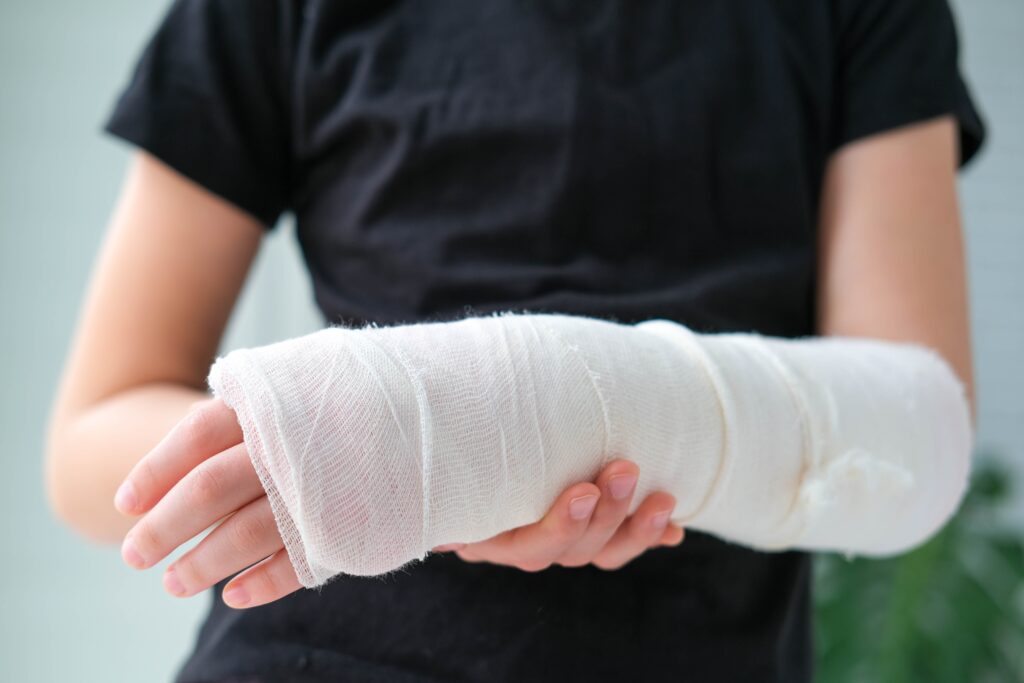How to determine the rate of bodily injury from forearm and wrist injuries according to the law in Vietnam?
How to determine the rate of bodily injury from forearm and wrist injuries according to the law in Vietnam? Thank you!

How to determine the rate of bodily injury from forearm and wrist injuries according to the law in Vietnam? - image from internet
The rate of bodily injury from forearm and wrist injuries is determined in accordance with Chapter 7 of Circular 22/2019/TT-BYT, which specifies the percentage of bodily impairment used in forensic assessment as follows:
|
No. |
Injury |
Percentage % |
|
IV. |
Forearm and elbow joint |
|
|
1. |
Dislocation of an elbow joint |
61 |
|
2. |
Amputatation of a forearm |
|
|
2.1. |
Cut line 1/3 above |
56-60 |
|
2.2. |
Cut line 1/3 from the middle down |
51-55 |
|
3. |
Fracture of the olecranon of the ulna |
|
|
3.1. |
Simple fracture without affecting the joint |
6-10 |
|
3.2. |
Fracture of the olecranon of the ulna causing deformity and stiffness of an elbow joint |
|
|
3.2.1. |
Forearm can be flexed - extended in the range of 5° to 145° |
11-15 |
|
3.2.2. |
Forearm can be flexed - extended in the range of 45° to 90° |
26-30 |
|
3.2.3. |
Forearm can be flexed - extended in the range of 0° to 45° |
31 - 35 |
|
3.2.4. |
Forearm can be flexed - extended in the range of 100° to 150° |
51 -55 |
|
4. |
Old dislocated elbow |
|
|
4.1. |
Dislocated elbow can be treated |
3-5 |
|
4.2. |
Old dislocated elbow prone to recurrence |
11-15 |
|
4.3. |
Dislocated radial - ulnar joint can be treated |
1 -3 |
|
5. |
Fracture of both forearm bones |
|
|
5.1. |
Non-union of bones or bone loss forming a false joint of two bones |
|
|
5.1.1. |
Tight false joint |
26-30 |
|
5.1.2. |
Loose false joint |
31 -35 |
|
5.2. |
Good alignment, near-normal function of the forearm |
11-15 |
|
5.3. |
One bone well-aligned, one bone poorly-aligned |
16-20 |
|
5.4. |
Poorly-aligned bone, skewed axis, short limb under 3cm |
26-30 |
|
5.5. |
Poorly-aligned bone, skewed axis, short limb over 3cm, affecting the function of flexion - extension of the forearm and wrist joint movement |
31 -35 |
|
5.6. |
Four bone heads fused together, poor alignment, loss of forearm flexion - extension, muscle atrophy |
31-35 |
|
6. |
Fracture of both lower ends of the forearm bones near the wrist |
|
|
6.1. |
Limited wrist joint movement few and moderate (1 to 2/5 wrist movements) |
16-20 |
|
6.2. |
Limited wrist joint movement many (over 3 wrist movements) |
21 -25 |
|
6.3. |
Stiff wrist joint in functional position (0°) |
21-25 |
|
6,4. |
Stiff wrist joint in maximum flexion or extension position |
31 -35 |
|
6.5. |
Stiff wrist joint in remaining positions |
26-30 |
|
6.6. |
Old dislocated wrist prone to recurrence |
11 - 15 |
|
6.7. |
Dislocation of the wrist joint capsule affecting wrist joint movement slightly, not affecting aesthetics |
1 -3 |
|
6.8. |
Dislocation of the wrist joint capsule affecting wrist joint movement significantly or affecting aesthetics |
4 - 6 |
|
7. |
Fracture of the radius shaft |
|
|
7.1. |
Good alignment, straight axis, no shortening, relatively normal function of the forearm |
6- 10 |
|
7.2. |
Poorly-aligned bone, skewed axis or short limb causing dislocation of the radial - ulnar joint and limited flexion - extension function |
21-25 |
|
7.3. |
Non-union of bones or bone loss forming a false radial bone joint |
|
|
7.3.1. |
Tight false joint |
11-15 |
|
7.3.2. |
Loose false joint |
21 -25 |
|
8. |
Fracture of the upper part of the radial head with sequelae causing limited flexion-extension of the elbow joint and limited pronation-supination, wrist flexion, accompanied by muscle atrophy |
21-25 |
|
9. |
Fracture of the lower part of the radial head (Pouteau - Colles type) |
|
|
9.1. |
Good treatment outcome |
6- 10 |
|
9.2. |
Limited movement of the wrist, wrist |
11-15 |
|
10. |
Fracture of the shaft of the ulna |
|
|
10.1. |
Good alignment, straight axis, no impact on the function of the wrist |
6- 10 |
|
10.2. |
Poor alignment, skewed axis or both ends of the fracture attached to the radial head causing loss of supination, wrist extension |
21 -25 |
|
10.3. |
Non-union of bones or loss of bone segment forming a false joint |
|
|
10.3.1. |
Tight false joint |
11-15 |
|
10.3.2. |
Loose false joint |
16-20 |
|
11. |
Fracture of the upper 1/3 of the ulna and dislocation of the radial head (Monteggia type fracture) without leaving sequelae * Note: If stiffness of the elbow joint sequelae is left: Calculate the percentage of disability according to section IV.3.2. |
6-10 |
|
12. |
Fracture of the radial styloid or ulnar styloid does not affect the movement of the wrist joint * Note: If it affects the movement of the wrist joint, calculate the percentage of disability according to the degree of limitation of wrist joint movement. |
6- 10 |
Best regards!










